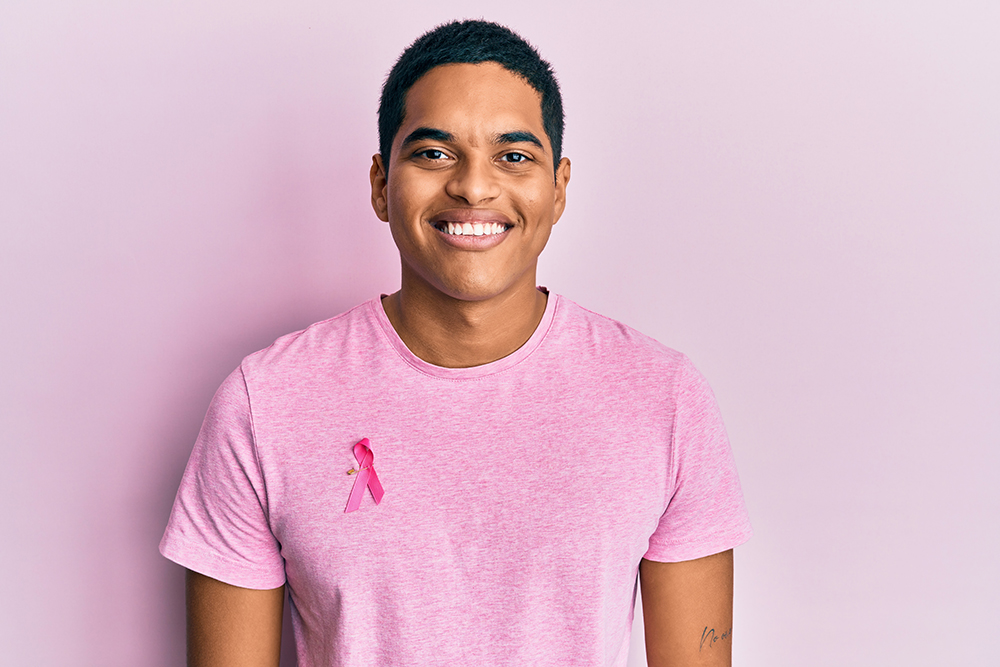
While breast cancer in men is rare, it’s important to know the signs to avoid a late-stage diagnosis.
Breast cancer doesn’t only affect women. While it’s a rare occurrence — accounting for about 1% of all new breast cancer cases each year, according to the Centers for Disease Control and Prevention — men are also susceptible to the disease.
“Men can get breast cancer because although they have less volume, men have breast tissue, too,” explains Emily Siegel, MD, a breast surgical oncologist who treats patients at the USC Norris Comprehensive Cancer Center, part of Keck Medicine of USC.
Even though a man’s risk of developing breast cancer is far lower compared to other malignancies like prostate or colon cancer, it’s still important to be aware of the warning signs. Research shows that since men are not typically screened for breast cancer, it’s more likely that the cancer will have already spread to other areas by the time they receive a diagnosis.
What are the risk factors of breast cancer in men?
Risk factors that can increase a man’s chances of getting breast cancer include:
Genetics
Both women and men can carry mutated BRCA1 or BRCA2 genes that increase the odds of developing breast cancer, including at younger ages. “If you have a family history of breast and ovarian cancer, then getting tested for a genetic mutation is worthwhile,” says Dr. Siegel, who is also an assistant professor of clinical surgery at the Keck School of Medicine of USC. She adds that testing is usually done using saliva or a blood sample.
Hormones
An increased estrogen-to-testosterone ratio can be a contributing factor. Klinefelter syndrome, a disorder that causes males to be born with an extra X chromosome, can cause elevated estrogen levels. Taking exogenous estrogen, including for gender-affirming care, may also increase the risk of developing breast cancer.
The American Cancer Society says other conditions that impact hormones, like liver disease and obesity, may be linked to breast cancer in men, as well.
Radiation exposure
Exposure to radiation in the chest area can raise the risk of breast cancer — for example, in patients who underwent radiation therapy for a different type of cancer.
All that being said, Dr. Siegel cautions that it’s still possible to get breast cancer even without any of these risk factors. She says it’s often challenging to pinpoint the exact reason why a man developed breast cancer. “In most cases, there was no specific identifiable risk factor. Sometimes, it’s just bad luck.”
What are the symptoms of men’s breast cancer?
The signs of breast cancer in men are similar to signs in women. Men may notice a lump that feels like a rock or a ball. “Male breast cancer is usually retroareolar, meaning it will be in the tissue behind the nipple, as opposed to women, where it more commonly occurs in all areas of the breast,” explains Dr. Siegel.
“Any nipple discharge would be concerning in a male,” Dr. Siegel adds. She says changes to the chest area are also concerning, like flaky or scaly skin, discoloration or if the nipple becomes inverted.
She recommends all patients pay close attention to their bodies while washing themselves. “Create that muscle memory so that you’ll notice if something seems different.”
Dr. Siegel says when she sees male patients for possible breast cancer, she’ll do a mammogram or ultrasound. “We’re usually trying to rule out gynecomastia, which is where breast tissue gets bulkier and can feel like a mass, but it’s not cancerous.”
If needed, the next step is a core needle biopsy. “We put a needle in the mass, take out a small piece and send it to pathology” to test whether it’s cancer.
How is breast cancer treated in men?
Dr. Siegel says in her experience, most male patients opt for a mastectomy to remove the entire breast. She says during the procedure, the surgical team usually checks the patient’s lymph nodes to determine if the cancer has spread.
Once the size and spread of the cancer has been determined, additional options may include chemotherapy, hormone therapy and radiation. “The rest of the adjunct therapies are very much individualized based on the patient,” says Dr. Siegel.
She warns that “men more often have disease that has spread to the lymph nodes or to areas outside the breast — not because of a biological difference in the cancer but because men often present at a later stage,” Dr. Siegel says.
That’s why she stresses that it’s important for men to be aware that breast cancer is a possibility and that they shouldn’t feel embarrassed to ask questions about it. “You can be your best advocate.”
Topics
